
drawing, print, etching, engraving
#
drawing
# print
#
etching
#
caricature
#
old engraving style
#
personal sketchbook
#
15_18th-century
#
men
#
genre-painting
#
engraving
Dimensions: sheet: 13 1/4 x 8 9/16 in. (33.7 x 21.8 cm)
Copyright: Public Domain
Curator: This is "An Honest Fellow," a print made around 1790 by George Murgatroyd Woodward. It's currently held at the Metropolitan Museum of Art. Editor: Hmm, an etching…The lines are so precise, almost cruelly so. The shadow of this… fellow, let’s call him, it’s almost more substantial than he is. There's a definite critique in play here. Curator: Yes, Woodward was known for his caricatures. Prints like this were immensely popular, and served as a powerful form of social commentary in late 18th-century Britain. It seems to target the leisure classes. Editor: He does cut a dapper, yet rather hollow figure. I get a sense of him desperately trying to convince himself of something, maybe of his own honesty as implied by the artwork’s title? There is an inscribed text below him that reads, "He that loveth pleasure shall be a poor man. He that loveth wine and oil shall not be rich." Quite direct, don’t you think? Curator: Precisely! And it’s not just about personal morality. This imagery fed into wider anxieties around social mobility and the perceived decline of traditional values amidst rapid economic change. Woodward is participating in and reinforcing a pretty standard social critique that those pursuing wealth will fail morally. Editor: So it's the visual equivalent of a finger-wagging? Except the finger is wielding an etching needle. Still, is it effective? The subject seems detached. I'm not entirely sure if it provokes real introspection, or simply reinforces existing biases. Curator: The impact would likely depend on the viewer, of course. For the already pious or financially anxious, it’s validation. For others, perhaps just a chuckle at another’s expense, or an early form of public shaming for others to scorn and feel elevated to. Editor: That last option feels closest to what I get from this piece…a desire for that sense of social elevation via comparison, for viewers throughout time. This old fellow in this old print serves his purposes even now! Curator: It is precisely that ongoing ability for art to provoke, to remind, or to provide the capacity to scorn that solidifies its historical worth. Thank you. Editor: And to you as well. An interesting little chat.
Comments
No comments
Be the first to comment and join the conversation on the ultimate creative platform.













